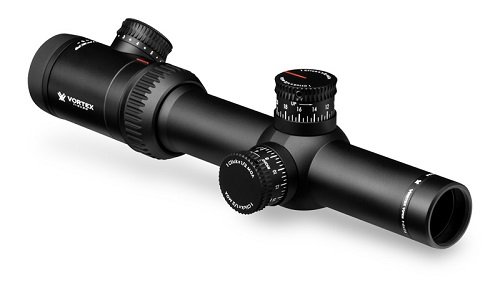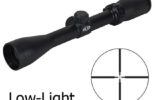 The Mini-14 is a lightweight semi-automatic carbine made by Sturm Ruger, a renowned American gun company. Its name, Mini-14, was actually derived from the military’s legendary and battle-tested M14 rifle, which was used by Ruger as base model to advance a few cost-cutting modifications and improvements to the new rifle.
The Mini-14 is a lightweight semi-automatic carbine made by Sturm Ruger, a renowned American gun company. Its name, Mini-14, was actually derived from the military’s legendary and battle-tested M14 rifle, which was used by Ruger as base model to advance a few cost-cutting modifications and improvements to the new rifle.
The Mini-14 is designed for optimum use with a telescope sight to provide more shooting reliability and accuracy; thus, Ruger outfitted an integral scope base on the gun’s receiver for adaptable use. A scope for the mini should be proportionately light, and powered high enough to tackle distances between 300-600 yards, which the mini is capable of. With this in mind, we have identified several of the finest scope models in the market to complete your Mini-14.
Contents
1. BARSKA 6.5-20×50 AO Varmint Target Dot Riflescope

The BARSKA 6.5-20×50 AO Varmint Target Dot Riflescope is lightweight, weighing barely 22 oz. It is designed for precision and long-range shooting, which works perfectly for target-shooting and varmint hunting.
It is definitely one of the best cheap scope models in the market, according to customer reviewers on Amazon. The Barska Varmint Target Riflescope provides a large and adjustable 50mm objective lens that produces 6.5 to 20 times variable magnification for better light transmission.
It has standard 1-inch diameter tube. Scope caps are provided for lens protection. The riflescope is well-built and shockproof with 100% water-proofing and fog-proofing capabilities that can ride out harsh elements and grueling terrains, according to customer reviewers on Amazon.
The scope has multi-coated optics that deter reflections; target-dot reticles for improved sighting performance; calibre-proof elevation adjustment for improved accuracy from any position or altitude; click values of 1/8 minute calibrations for precise fine tuning. The exit pupil varies from 7.7mm to 2.5mm.
Following a mobile target is facilitated with a field of view of 16 feet at 100 yards for magnification of 6.5x, and 5.7 feet even at 20x. The eye relief is not so generous at 3.6 inches, but mini-14 is not that notorious for recoil.
2.Vortex Viper PST 1 – 4x24mm Riflescope

The Vortex Viper PST 1 – 4x24mm Riflescope features a sturdy, mean-looking 30mm-diameter tube that is made of aircraft-grade aluminium.
It is equipped with a dead-hold BDC reticle designed to reduce guesswork on bullet hold-over and windage corrections, and a side parallax adjustment with range numbers clearly visible to allow for fast and easy fine-tuning while in shooting position, according to customer reviewers on Amazon.
The Vortex Viper 6.5-2050 PA riflescope is capable of absorbing harsh recoils, fog-proof and water resistant.
The fully-multicoated optics delivers 95%-clear light transmission. With 50mm objective and oversized tube of 30mm diameter, the Viper becomes the ideal scope for accurate long-range shooting and sporting applications.
The pull-up turret is well-thought-out with a few easy clicks, you’re dead on target, according to customer reviews.
This riflescope measures 16x5x4 inches and weighs a good 3 pounds for durability. Best of all, it comes with a “no questions ask” warranty – a defective or damaged scope will be fully replaced by Vortex regardless of the circumstances surrounding its impairment. You can get this terrific scope for around $500.
3. Trijicon TR23 AccuPoint 5-20×50 Riflescope MIL-Dot Crosshair

Apart from its durable aircraft-grade hard-anodized aluminium tube, Trijicon has come up with another gem in its line of scopes – the new and powerful Trijicon 30mm-tube Accupoint 5-2050 Riflescope.
It utilizes cutting-edge fibre optics technology and tritium dual-illumination system that set the reticle brightness level and contrast automatically for quick target acquisition at dawn, dusk, or even heavy cloud cover.
If you find the need to control the light output of the optics, you can use the manual brightness override to suit your personal preference.
It’s also equipped with mil-dot crosshair reticle and side parallax settings for increased long-range shooting reliability and accuracy.
This powerful scope sports a multi-layer lens coating that gathers a great deal of light for crystal-clear and exceptional light transmission. It comes with eye relief of 3.8mm-4.1mm – quite adequate for the mini-14.
Take note of the numbers: exit pupil is 10mm to 2.5mm; FOV is 19 feet to 5.1 feet at 100 yards; weight is 27 oz; ¼ MOA graduations per click.
The price is quite hefty at around $1,300, but the package comes with a lifetime warranty plus amazing extras on the side like sunshade, Trijicon logo sticker, a manual, a set of lens caps, lens pens, and warranty card.
Buyers guide for the best scope for Mini-14 in 2017
The key to enhancing the accuracy and precision of a shot being taken is to magnify the target being shot at.
Needless to say, it is much easier to shoot a gun with a scope than with iron sights which require lining up the rear and front sights with the target.
With a scope, you need only to line up your reticle (commonly called crosshairs) with your target; it makes for target acquisition quick and easy as they appear much closer and easier to see than without one.
A buyer must know the basic components to look for in a scope.
Power or magnification
A scope with these numbers 3-9x50mm – has a magnification of 3-9x. The numbers refer to the number of times the image or object appears when seen through the scope, as it is compared to the image as it appears to the naked eye. The range of 3-9 means that the magnification is variable from 3x through 9x.
Light transmission
You’d want a scope that transmits light most efficiently especially for low-light conditions, such as dawn or dusk.
A scope makes use of whatever light is available and transmits as much of this light as possible.
Scopes that are good transmitters of light usually have larger objective lens diameter and exit pupil, and lower magnification.
In the scope mentioned earlier, the third number, 50, is the objective lens diameter in millimeters (thus, objective lens = 50mm). From these numbers you may compute the exit pupil by dividing the objective lens by the magnitude.
Therefore, the exit pupil is 16.67mm at 3x magnitude (50 divided by 3), and 5.55mm at 9x (50 divided by 9).
It is important to read the specifications of several scopes before making your final purchase.
Also look into these features: eye relief (at least 4 inches especially for guns that are notorious at recoil), field of view (you’d need a wider FOV for highly mobile targets), parallax adjustments, tube diameter, wind and elevation adjustments, and coatings.
The scope that you choose must one that best matches your shooting style and personal specifications.


Reply